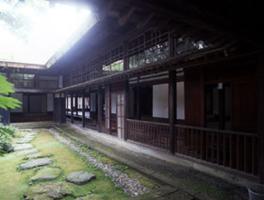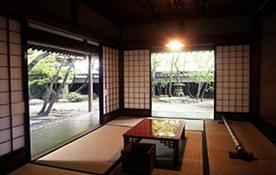

 Kazama family had grown as merchants who enjoyed government patronage from the Shonai
domain at the foot of Tsurugaoka Castle. As the wealthiest merchants in Tsuruoka,
the Kazama family was later devoted to promoting the development of industry.
Heishin-do was built in 1896(Meiji 29) – a year referred to as Heishin in the
Chinese calendar – by Kazama Koemon the seventh master of the Kazama family as a
residence and the base of their business. The building gives the impression of
the prosperity of the merchant family from its yakui-mon, the type of gate which
normally only samurai (buke) were allowed to build; which is why it used to be
called buke-mon 200 years ago. Heishin-do is characterized by the unique ‘ishioki-yane’,
the roof laid with 40,000 stones, and consists of a centered main block, four storehouses,
the house’s central pillar in a large room with a wooden floor. Designated an Important National
Cultural Asset, the historical heritage attracts people and shows them the image of the old wealthy
merchant lifestyle. The scene of the reunion of Bunshiro and Ofuku in the movie “Semishigure (Chorus of Cicadas)”
which was based on the book by Shuhei Fujisawa was filmed in a small Japanese-style room in Heishin-do.
Since it was released nation-wide in October 2005, this film location became a popular tourist spot with
visitors to see open set and Semishigure museum.
Kazama family had grown as merchants who enjoyed government patronage from the Shonai
domain at the foot of Tsurugaoka Castle. As the wealthiest merchants in Tsuruoka,
the Kazama family was later devoted to promoting the development of industry.
Heishin-do was built in 1896(Meiji 29) – a year referred to as Heishin in the
Chinese calendar – by Kazama Koemon the seventh master of the Kazama family as a
residence and the base of their business. The building gives the impression of
the prosperity of the merchant family from its yakui-mon, the type of gate which
normally only samurai (buke) were allowed to build; which is why it used to be
called buke-mon 200 years ago. Heishin-do is characterized by the unique ‘ishioki-yane’,
the roof laid with 40,000 stones, and consists of a centered main block, four storehouses,
the house’s central pillar in a large room with a wooden floor. Designated an Important National
Cultural Asset, the historical heritage attracts people and shows them the image of the old wealthy
merchant lifestyle. The scene of the reunion of Bunshiro and Ofuku in the movie “Semishigure (Chorus of Cicadas)”
which was based on the book by Shuhei Fujisawa was filmed in a small Japanese-style room in Heishin-do.
Since it was released nation-wide in October 2005, this film location became a popular tourist spot with
visitors to see open set and Semishigure museum.
|
1-17 Baba-cho, Tsuruoka City
TEL 0235-22-0015
[Open hours] 9.30-16.00
[Days not open] 1/Dec to 9/Apr,
Mondays (Tuesday when Mon is public holiday)
[Entry Fees/ ¥]
Adults: 300, Junior / Primary school students: 150
(Combined ticket for both Heishin-do and ‘Infinite light’ Villa(Muryokoen-Shaka-do) /Senior high school students and above:400, Junior/Primary school students:200)
[Access] From Tsuruoka Station, 5 minutes by bus on the Yunohama route to the Ginza Street stop, then 3 minutes on foot
|
 |
 |
|
| |
|


